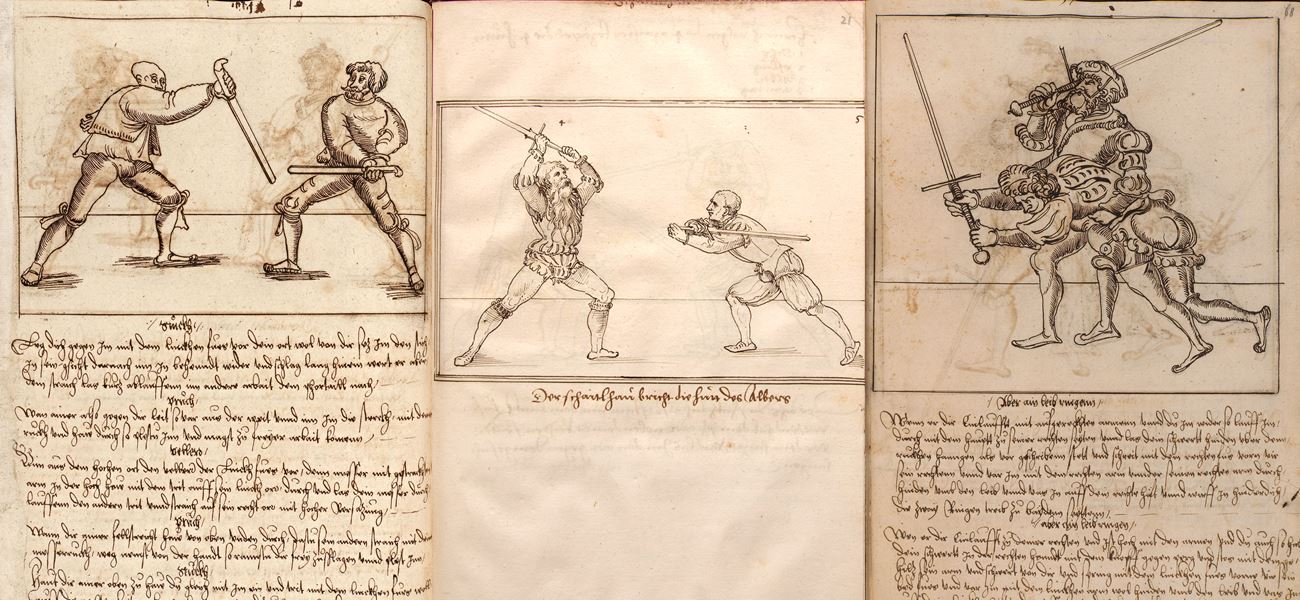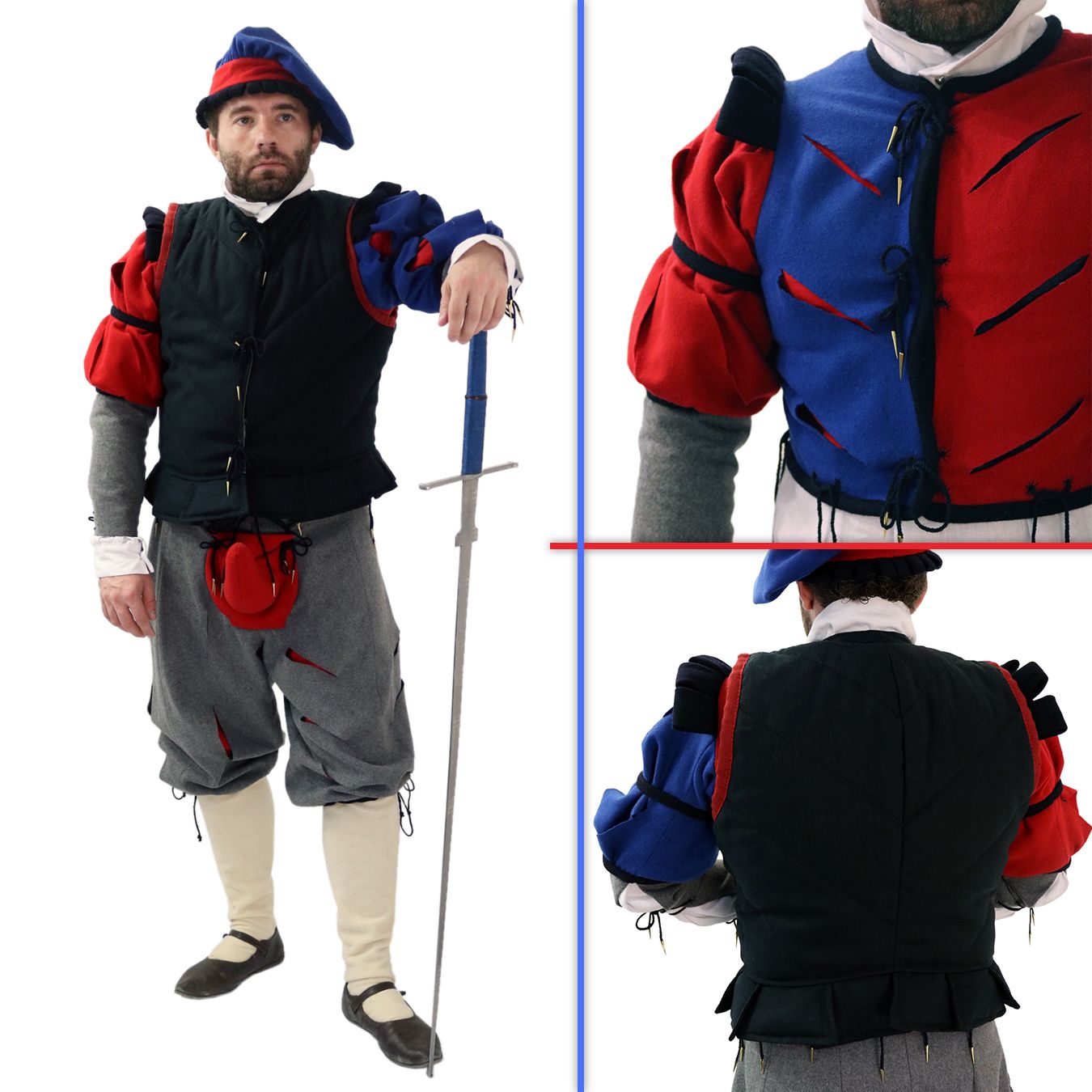Warhammer v 16th century treatises – Landsknecht LARP/HEMA costumes
Warhammer v 16th century treatises – Landsknecht LARP/HEMA costumes
Warhammer Fantasy probably needs no instruction. However, for those of you who have just discovered this title, let me introduce it as a fantasy universe similar to late medieval Europe. Among magical creatures – like dragons, vampires or lizardmen – it consists of characters inspired by history. Thus, the fact that some formations from this medieval-like universe refer to real armies from the renaissance period is no surprise.
There is no need to look far for a proper trail. Take a look at the leading forces in Warhammer. Armies of the Empire, which work as an equivalent of the Holy Roman Empire of the German Nation. It is easy to notice that clothing of each unit are variations of garments from the end of the 15th and 16th centuries. Multitude of colors, style joining together loose and fitted cuts, rich adornments, stitched frills, or characteristic incisions with visible lining in contrastive color, making geometric shapes. Sounds familiar? Not without a reason.
Similar clothing was typical for landsknechts – formation of infantry deriving from German-speaking countries. Its soldiers served as mercenaries in various European lands. Characteristic features of their garments – bright colors, puffy trousers, fitted jackets, stockings, sizable hats with feathers – became an inspiration not only for Warhammer creators, but also for us. Lately, we have received an order for a very special LARP costume of an Empire Army soldier from witch hunters unit. How cool is that?
Reaching for sources: treatises and saved costumes as inspiration for Warhammer LARP costume
Challenge has been accepted. Now let’s proceed with the project. To make a landsknecht costume, we have reached for European sources from the 15th and 16th centuries. Treatises from the half of the 16th century include the most useful prints.
Hutter/Solingen Fechtbuch
Illustrations from Hutter/Solingen Fechtbuch were exceptionally helpful in making our Warhammer Landsknecht costume. It is a treatise consisting of two parts, created by different authors. First one comes from 1523 and it was written by Jörg Wilhalm Hutter. The other one, by Lienhard Solingen, is dated 1564. Works differ in style and type of illustrations. However, despite a few decades of break, both parts contain drawings of typical Landsknechts costumes. Colorful, high-waisted trousers with cuts or doublets with spacious ruffles and incised sleeves are features which drew our attention in particular.

Jörg Breu Draftbook
Another useful treatise is titled Jörg Breu Draftbook and it comes from 1645. Just like in Solingen Fechtbuch, this one also includes black and white illustrations. You can find similarly decorative garments there, but together with less complicated designs, without unnecessary ornaments. What is important, this book contains a simple vest. It is an essential part of the soldier’s costume, and loose trousers similar to our Light HEMA pants. This design inspired us to create the final product.
Joachim Meyer treatise
Considering how loose and wavy should the costume be, we have decided to take a look at the famous Joachim Meyer treatise. This 1560 work presents colorful clothing, but more spacious than in previous books. In the end we didn’t want our product to be that puffy. However, Meyer inspired us with a vest which can be worn on the outer layer. We believed this would be a proper finial of our landsknecht costume.

Arming doublet from the 16th century
Apart from fencing treatises, another inspiration for us comes from arming garments from the 16th century. These days we don’t have much of preserved doublets of this type, but it’s impossible to ignore them. One example, coming from Western Europe of 1580, especially stands out. Very rich and elaborately finished. Take a look at the lower edge. We are sure this detail will underline the temper of our character and Warhammer LARP costume.

Source: metmuseum.org
Now let’s assemble our Landsknecht costume
Before we sum up our project, we would like to underline that our Landsknecht costume is not a copy or reconstruction. It is a variation on a popular Warhammer costume, inspired by historical sources. Customer’s requests, the budget and other specifications also have influence on the final result. So, how will this Landsknecht costume actually look?

Stocking or hose reaching knees cover calves. Upper leg parts – with loose trousers based on our Light pants model, made of high quality wool with incisions and contrastive lining. A short doublet with widened, slightly wavy sleeves, revealing the shirt layer worn under cover a shirt. The doublet itself reaches the navel area and is tied up symmetrically in front. There are incisions on chest, back and arms, revealing the contrastive lining. Quilted vest with front closure and overlapping elements on the bottom part is worn in the 16th century arming doublet. This Warhammer LARP costume requires accessories: a headwear, belt, aiglets, stamps etc.

Landsknecht costume for HEMA – how should it look?
What should we change in this design to make this Warhammer Landsknecht costume appropriate for HEMA? To provide a proper protection against injuries, we should use an outer layer of higher puncture resistance. Let’s make it 800N or 350N. Later, we should add a bladecatcher, an overlap on closure, a zipper (OR button closure of high density, OR velcro closure). Another important feature would be removing all the gaps in the costume. To do this, we would cover them with a puncture resistant fabric – on sleeves and between upper and lower parts. On sensitive areas we would also place an amortization.

Now, what about incisions and waves? As a safety precaution, we should remove them. However, to somehow refer to the Landsknecht costume, we would add bright stripes imitating incisions and adding extra colors to the gear. Our 16th century HEMA set consists of modified Light pants and JF jacket. We would surely add a vest to it, functioning as a plastron with minimal amortization.
Thanks to these minor modifications in our standard SPES products we receive a gear of a completely different character. Let me know how you like this type of HEMA set.




Zostaw odpowiedź Cofnij odpowiedź